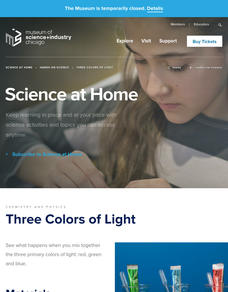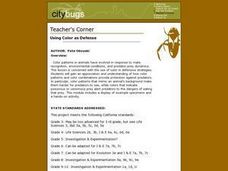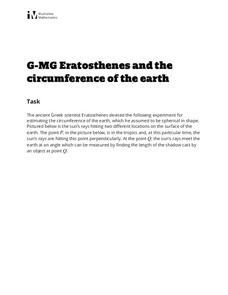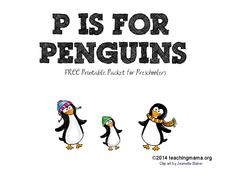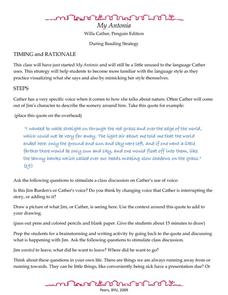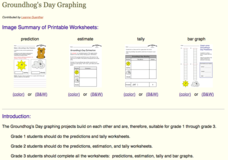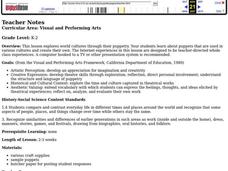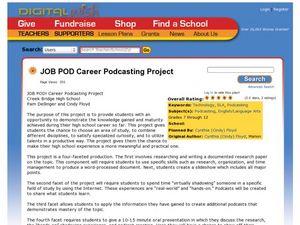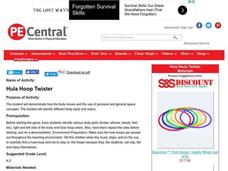Museum of Science
Three Colors of Light
It only takes three colors. Using three-colored glow sticks, pupils observe what happens when colors of light mix together. Learners use the material from a red, green, and blue glow stick to mix together. By mixing small amount of the...
Curated OER
U Can Two Can Workout
Students spread out around the activity area, having enough space so they are not touching each other. They each hold two canned goods (10-16 oz). Students perform various exercises to the music. They do exercises such as: arm circles,...
Curated OER
Surveying and Assessing the Environmental Compatibility of a Building Construction Site
Students examine an area of land and assess its suitability for construction purposes. This project requires a vast amount of hands-on experimentation, data analysis, community involvement, and job shadowing/career awareness.
Curated OER
Commemoration of the Gettysburg Battlefield
Students use a multimedia project, The Valley of the Shadow: Two American Communities in the Civil War, to create a presentation about the significance of the Gettysburg Address. They work on expert teams to explore the interactive...
Curated OER
Using Color as Defense
Middle schoolers explore mimicry and crypsis, participate in hands-on predator-prey activity, and practice calculating averages and graph results in histogram.
Florida Center for Reading Research
Phonics, Letter-Sound Correspondence: Letter Bag
An activity focuses on final sounds sorting. Scholars pull objects out of a bag, identify what letter sound the object ends with, then draw the picture under the appropriate column.
Illustrative Mathematics
Eratosthenes and the Circumference of the Earth
The class gets to practice being a mathematician in ancient Greece, performing geometric application problems in the way of Eratosthenes. After following the steps of the great mathematicians, they then compare the (surprisingly...
Lawrence Hall of Science
DIY Sun Science
Get an up-close-and personal look at the sun from the safety of your classroom with this fun science application. Offering numerous activities, images, and videos, the resource supports children of all ages as they learn about the sun.
Teaching Mama
P is for Penguins
Practice printing, matching, tracing, cutting, coloring, and more with a packet full of penguins! Allow these perky winter animals to help your kids out as they work on these skills.
Johnson County Community College
Treasured Stories by Eric Carle
Explore the works of Eric Carle with a set of four lessons focused around the stories, Brown Bear, Brown Bear, What Do You See?, Papa, Please Get the Moon For Me, and The Very Hungry Caterpillar. Young readers develop a storyboard,...
NOAA
The Great, Glowing Orb What You Will Do: Make a Solar Heat Engine
How is solar energy able to move wind and water to control the climate? Scholars explore the concept of solar energy in the first of 10 activities in the Discover Your Changing World series. They follow instructions to build homemade...
Biology Class
Scientific Method Worksheet
Knowing the names of the steps of the scientific method is not enough; in order to really understand each of the elements, one must practice. Beginning with an engaging recap of the steps of the scientific method, learners practice the...
Curated OER
My Antonia: During Reading Strategy
Home in on the quote on this page to explore setting, the author's and character's voices, and plot in Willa Cather's My Antonia. Pupils draw a picture of what is described in the quote, discuss the content, and make connections to their...
NASA
Lights on the International Space Station
Groups explore illumination with NASA's Lighting Environment Test Facility (LETF) as a context. Using the TI-Nspire app, groups determine the lux equation that models their simulation. They then use the lux equation to solve problems...
University of Texas
Observing the Moon
Why does it look like there is a man on the moon? Why does the moon look different every night? These are the focus questions of a lesson that prompts class members to observe and record the nightly changes of Earth's natural satellite.
Kid Zone
Groundhog's Day Graphing
This Groundhog's Day, challenge scholars to predict, estimate, tally, and graph in a weather-themed lesson in which class members play the role of the groundhog to forecast the weather come February second.
Curated OER
PUPPETRY
Students explore world cultures through their puppetry. Your students explore puppets that are used in various cultures and create their own. The Internet experiences in this instructional activity are designed to be teacher-directed...
Curated OER
Colored Shadows
Sixth graders explore how three colored lights can be combined to produce a wide range of colors.
Curated OER
Toilet Plunger Sundial
Students build a sundial to measure the local noon time. In this third grade science lesson plan, students build a sundial out of common materials and align to measure the local noon. This lesson plan is a hands-on tracking of the sun,...
Curated OER
JOB POD Career Podcasting Project
Learners use Podcasting technology as a part of a career exploration. In this career and technology lesson, students research and write a documented research paper on the topic. Learners use specific skills such as research,...
Curated OER
Water 1: Water and Ice
Students explore forms that water can take. In this science instructional activity, students participate in hands-on activities that require them to change water to a solid and back to a liquid again.
Curated OER
Activity Plan Mixed Ages: Sunny Science
Students develop problem-solving, observation, and critical-thinking skills. In this early childhood lesson, students explore the topic of the sun as they notice shadows and light.
Curated OER
Hula Hoop Twister
Students demonstrate how the body moves and the use of personal and general space concepts.Students identify different body parts and colors.students identify various body parts (knees, elbows, hands, feet, etc), right and left side of...
Curated OER
The Groundhog Came Out of His Hole
Students sing the song "The Groundhog Came Out of His Hole". For this music lesson, students sing a song and come up with matching hand motions. They use the same tune to make their own song.


